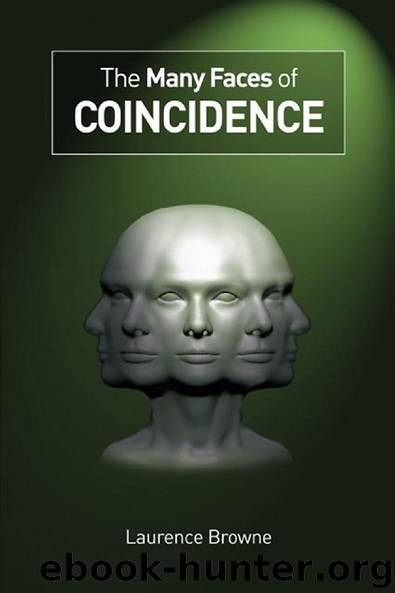The Many Faces of Coincidence by Laurence Browne

Author:Laurence Browne
Language: eng
Format: epub
Tags: Coincidence, synchronicity, Jung, mind and matter, tao, chance, cosmos, parapsychology, telepathy, depth psychology, quantum physics, entanglement, cosmology, goldilocks universe
ISBN: 9781845409524
Publisher: Andrews UK Limited 2017
Published: 2017-11-09T00:00:00+00:00
Fig. 6: Box-pair Experiment
[36]
The reason why the boxes are arranged in a parallel position is because at the far end of each box is another slit. These slits need to stay closed for the wave-packets to remain trapped but can be opened, either in tandem or separately. Not pictured in the diagram but directly to the right of the boxes there is a recording screen that can display where the wave/particle lands, if either one or both slits are opened. As it turns out, when the procedure is repeated and both slits are opened a sufficient number of times an interference pattern appears on the screen, just as in the usual quantum double-slit experiment. But in a subtle twist that brings out the starkness of this version of the experiment, when only one of the slits is opened, one of two results is possible: either the whole particle shoots out and lands on the recording screen, though in ‘bullet’ formation rather than as part of an interference pattern; or nothing emerges from the box, meaning that the particle - for instance, an atom - is now wholly in the box not selected.
In other words, when only one of the boxes is opened, the wave function of the atom collapses: one box has the entire atom; the other is empty. Before that, the wave function of the atom was present in both boxes, even though the boxes are in distinct locations and interaction between them is out of the question. So we have a three-card trick of the highest order, and it is impossible to guess which box will contain the atom. The probability for each box is exactly half, but unlike the sleight of hand of even the most skilful magician, the whereabouts of the atom can never be known before one of the boxes is inspected. [37]
In terms of the actual experiment, the boxes do not physically need to be opened to ascertain which one contains the atom. Just by shining a beam, the gleam of the atom can be discerned. [38] The introduction of the beam itself is sufficient to collapse the wave function and cause the atom to emerge from its indeterminate ‘superposition’ state and coalesce in one of the boxes, leaving the other vacant. The point here is that the observer has a choice of whether to open one of the boxes, a procedure Rosenblum and Kuttner call a ‘which-box?’ experiment, or to open the slits of both boxes simultaneously and so perform an interference experiment. One outcome of this choice is that the experimenter’s decision in the present seems to be able to determine what has already occurred in the past. If the experimenter chooses to conduct an interference experiment, it means that the atom travelled into both boxes in wave form; but if a ‘which-box?’ experiment is selected, it means that the atom did not divide and instead went directly and fully into the box in which it was found.
Download
This site does not store any files on its server. We only index and link to content provided by other sites. Please contact the content providers to delete copyright contents if any and email us, we'll remove relevant links or contents immediately.
| Administration & Medicine Economics | Allied Health Professions |
| Basic Sciences | Dentistry |
| History | Medical Informatics |
| Medicine | Nursing |
| Pharmacology | Psychology |
| Research | Veterinary Medicine |
The Art of Thinking Clearly by Rolf Dobelli(10129)
The 5 Love Languages: The Secret to Love That Lasts by Gary Chapman(9500)
Mindhunter: Inside the FBI's Elite Serial Crime Unit by John E. Douglas & Mark Olshaker(9097)
Becoming Supernatural by Dr. Joe Dispenza(8032)
The Road Less Traveled by M. Scott Peck(7468)
Nudge - Improving Decisions about Health, Wealth, and Happiness by Thaler Sunstein(7453)
Mastermind: How to Think Like Sherlock Holmes by Maria Konnikova(7152)
Enlightenment Now: The Case for Reason, Science, Humanism, and Progress by Steven Pinker(7080)
Win Bigly by Scott Adams(7029)
The Way of Zen by Alan W. Watts(6446)
Factfulness: Ten Reasons We're Wrong About the World – and Why Things Are Better Than You Think by Hans Rosling(4620)
The State of Affairs by Esther Perel(4585)
Gerald's Game by Stephen King(4510)
Man's Search for Meaning by Viktor Frankl(4346)
The Confidence Code by Katty Kay(4153)
Thinking in Bets by Annie Duke(4115)
Hidden Persuasion: 33 psychological influence techniques in advertising by Marc Andrews & Matthijs van Leeuwen & Rick van Baaren(3413)
The Healing Self by Deepak Chopra(3394)
The Worm at the Core by Sheldon Solomon(3393)
